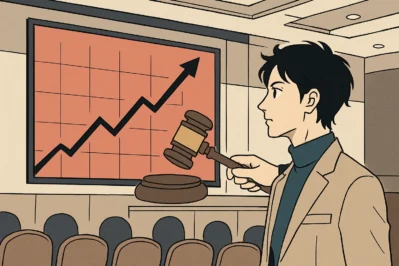Beyond the Gavel: Decoding the Korean Art Market
Hello! Welcome back to [Maeil Hangul], your guide to upgrading your Korean proficiency to the highest level!
Are you fascinated by art, investment, or the intricate dynamics of cultural economies? Today, we’re diving deep into a sophisticated topic: analyzing art auction results to predict market trends. This is the language you’ll need to discuss art valuation and cultural investment like a true insider.
Lately in Korea, the art market is buzzing with unprecedented energy, largely fueled by a new wave of young, tech-savvy collectors. Understanding the discourse surrounding this “Art-tech” (아트테크) boom is key to grasping contemporary Korean economic and cultural trends. Let’s learn the vocabulary to analyze this phenomenon like a pro.
Core Expressions for Market Analysis
Here are the essential terms you’ll encounter when reading an art market report or discussing auction outcomes.
- 1. 낙찰가 (Nak-chal-ga)
- Pronunciation [Romanized]: [Nak-chal-ga]
- English Meaning: Hammer price; successful bid price.
- Detailed Explanation: This is a crucial term in any auction context. It’s a compound noun made of 낙찰 (落札, nakchal), meaning ‘successful bid,’ and 가 (價, ga), meaning ‘price.’ The
낙찰가is the final price the auctioneer’s hammer falls on, before the buyer’s premium or other fees are added. It is the purest indicator of the market’s valuation for a piece. Don’t confuse it with 추정가 (chujeong-ga), the pre-auction estimated price, or the final 구매가 (gume-ga), the price the buyer actually pays.
- 2. ~을/를 기록하다 (~eul/reul gi-ro-ka-da)
- Pronunciation [Romanized]: [~eul/reul gi-ro-ka-da]
- English Meaning: To set a record; to post a figure; to reach a certain number.
- Detailed Explanation: While it literally means ‘to record,’ this verb is the standard, formal way to report statistics, prices, and records in news and analysis. Using
기록하다instead of a simpler verb like되다(to become) or나오다(to come out) lends your statement an air of objectivity and authority. It’s the preferred verb for reporting financial or statistical facts. For example, “최고가를 기록했다” (It set a record high price).
- 3. 시장의 바로미터 (Si-jang-ui ba-ro-mi-teo)
- Pronunciation [Romanized]: [Si-jang-ui ba-ro-mi-teo]
- English Meaning: A market barometer; an indicator of market trends.
- Detailed Explanation: This is a sophisticated metaphorical expression used frequently in economic and cultural analysis. 바로미터 (barometer) is a loanword used to describe a key indicator that reflects the health, state, or future direction of a larger system. When an artist’s auction results are called “시장의 바로미터,” it means their performance is seen as a benchmark for the entire art market’s vitality.
- 4. 귀추가 주목되다 (Gwi-chu-ga ju-mok-doe-da)
- Pronunciation [Romanized]: [Gwi-chu-ga ju-mok-doe-da]
- English Meaning: The future course/outcome is attracting attention; (something) is being closely watched.
- Detailed Explanation: This is a very formal and advanced phrase you will exclusively find in written reports, news articles, and formal presentations. 귀추 (歸趨, gwichu) is a Hanja-based word referring to the final outcome or the direction in which a situation develops. 주목되다 (注目되다, jumokdoeda) means ‘to receive attention.’ The phrase is a polished way of saying, “All eyes are on what happens next.” It’s used to build suspense and highlight the significance of future events.
Example Dialogue: Post-Auction Debrief
Let’s see how these expressions are used in a natural, high-level conversation.
A: 이번 서울 옥션 경매 결과 보셨어요? 박서보 화백의 작품이 또 최고 낙찰가를 기록했네요.
(Have you seen the results from the recent Seoul Auction? Park Seo-bo’s piece set a new record hammer price again.)
B: 네, 봤어요. 그의 작품은 정말 한국 단색화 시장의 바로미터라고 할 수 있죠. 이번 결과를 보니 시장의 열기가 식지 않은 것 같아요.
(Yes, I saw. His work is truly a barometer of the market for Korean Dansaekhwa. Looking at these results, it seems the market’s heat hasn’t cooled down.)
A: 맞아요. 특히 젊은 컬렉터들의 참여가 늘면서 시장 기반이 더 넓어지고 있어요. 다음 경매에서 신진 작가들의 작품이 어떻게 평가받을지 그 귀추가 주목됩니다.
(Exactly. The market base is expanding, especially with increased participation from young collectors. How emerging artists’ works will be valued in the next auction is drawing keen attention.)
Cultural Tip & Trend Deeper Dive
The phrase “귀추가 주목되다” is your key to unlocking Korean news articles about the art world. In Korea, the MZ generation’s interest in “아트테크” (Art-tech, a portmanteau of ‘art’ and ‘재테크’ or financial tech) is a major social phenomenon. They invest in art not just for aesthetic appreciation but as a tangible asset, often through fractional ownership platforms.
News headlines constantly use today’s vocabulary to cover this trend. For example: “MZ세대의 아트테크 열풍, K-아트 시장의 귀추가 주목된다.” (The MZ Generation’s Art-tech craze; the future of the K-Art market is drawing keen attention.) By understanding these expressions, you can move beyond simple conversation and engage with the complex economic and cultural discourses happening in Korea right now. You’re not just learning words; you’re learning the language of Korean cultural analysis.
Wrap-up & Practice
Today, we learned four advanced expressions—낙찰가, ~을/를 기록하다, 시장의 바로미터, and 귀추가 주목되다—to analyze the Korean art market like an expert.
Now, it’s your turn to practice!
- Fill in the blank:
이번 경매에서 김환기 화가의 작품은 예상가를 훌쩍 뛰어넘는 ___________(으)로 거래되었다.
(In this auction, Kim Whanki’s work was sold for a ________ that far exceeded the estimate.) -
Sentence Building:
Using the phrase “귀추가 주목되다,” write one sentence about a future trend you are interested in (e.g., AI development, the next K-pop evolution, etc.).
Leave your answers in the comments below! We’d love to see how you use these sophisticated expressions. Keep up the fantastic work






